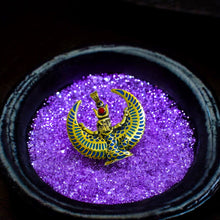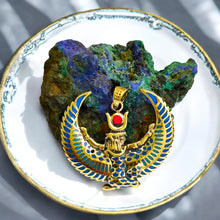
Embrace the divine energy and timeless beauty of ancient Egypt with our Large Gold Winged Goddess Isis Pendant Necklace. This striking piece, handcrafted with care, features the revered Goddess Isis with her wings spread wide—symbolizing protection, healing, and spiritual rebirth. Worn as a talisman, this pendant invokes inner strength, divine guidance, and a deep connection to sacred feminine power.
The pendant is crafted from a vintage-inspired alloy blend of 95% brass and 5% gold, giving it a warm, antique finish that honors the ancient artistry of Egyptian jewelry. The intricate wings of Isis are inlaid with turquoise stones, known for their protective and healing properties. A radiant red agate stone crowns her headdress, symbolizing vitality, courage, and grounding energy.
Designed to be both meaningful and versatile, this pendant fits chains up to 5mm in thickness, making it suitable for a variety of chain styles for both men and women.
Jewelry Care: To preserve the beauty of this handmade piece, avoid exposing it to moisture, perfumes, or harsh chemicals. Clean gently with a soft cloth and store in a dry, separate space to prevent tarnishing.
Symbolism: Isis, the Egyptian goddess of magic, motherhood, and healing, was revered across ancient civilizations as a powerful protector and nurturer. Her wings represent shelter, spiritual transformation, and divine grace, making this pendant a powerful spiritual accessory.
A Glance at History: Isis was one of the most worshipped deities in ancient Egypt, later spreading to the Greco-Roman world. She was often invoked in rituals for healing and guidance, symbolizing resurrection and eternal love.
Thank you for visiting our shop! We’re honored to share a piece of ancient magic with you. If you have any questions or need assistance, feel free to reach out—we’re happy to help.













